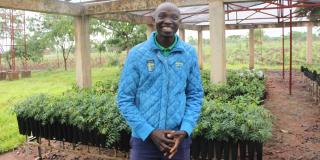Smoking fields and bare soil betray a common practice in this rural Mozambique district: slash and burn agriculture. The rural population here barely subsists on low-yield rice, cassava, and vegetables, and by cutting trees for charcoal and building materials.

Thatched-roof huts and abrupt hills, from termite mounds to rocky outcroppings, dot the rural landscape. But there are signs of environmental progress: strategically placed trees at schools and health centers that provide shade and a buffer from the wind and rain that can quickly destroy small villages.
The community can thank Esperança Para Novo Rebento (ESPANOR) for the new trees. ESPANOR is a small NGO that supports early education and local sustainability in Mozambique’s Milange District. Six years ago it formed a partnership with the International Programs Office of the USDA Forest Service and the U.S. Agency for International Development. The goal was to produce and plant robust seedlings and to show community members the value of trees. The project is ongoing, and 5-year-old, 3-meter (10-foot) tall trees demonstrate its success.

“We now get calls from people: schoolteachers, health administrators, individuals. They want to know how they can get trees,” said Paulo Raiva Chiconza, the community development manager for ESPANOR.
The government built schools and health centers on cleared land here. The Milange District sits on the border with Malawi, 300 kilometers (185 miles) inland from the Indian Ocean coastline that dominates much of the southern Africa country.
School children used to play in the red dust surrounding their classrooms. Now they are told to mind the newer trees in their football matches. Family members that used to wait in the hot sun for their loved ones seeking treatment now find some comfort in the shade.
As of Jan. 2024, ESPANOR has brought trees to 22 local schools and four health centers.
“We have each child plant and take care of a tree. They really like that,” said Chiconza.
The planting activities serve many purposes. They provide shade-giving, wind-breaking, fruit-yielding trees, and they teach kids about conservation.

Modesta Antoni Escrivão is a midwife with one of the health centers where ESPANOR first planted seedlings. A table and chairs sit under one of the now 5-year-old trees as a bike leans against another. Ms. Escrivão has become an advocate for tree planting since she joined ESPANOR at the health center in 2018. She planted a few of the seedlings around her nearby house. When a cyclone ripped through the village a year ago, her house remained intact.
“My neighbors now ask me for trees,” said Escrivão. She has since created her own small nursery operation.
The ESPANOR nursery project is small. The manager, Benito Vanoneia, is currently growing 7,000 seedlings and aims to increase that number by 50%. He rotates the seedlings out for planting every six months. Mr. Vanoneia has weekly WhatsApp check-ins with Forest Service nursery specialist Becca Lieberg. Together they tweak the growing substrate and consider new varietals to cultivate.
Community members particularly like fruit-bearing trees. The nursery is currently one-third full of citrus that Vanoneia grafted from local varietals in consultation with Lieberg.

The government in Milange District asked ESPANOR if they can restore the Tumbine mountain, the dominant (and deforested) hill that lies along the border with Malawi. ESPANOR isn’t ready for that big of a project, but the nonprofit is proud that the government has noticed and appreciates its tree growing and planting efforts around the district. For now, it is thrilled to be helping their community by reintroducing it to the value of trees and by providing it with the robust seedlings it needs to turn Milange green again.
Editor’s note: The quotes are translated from Portuguese.





